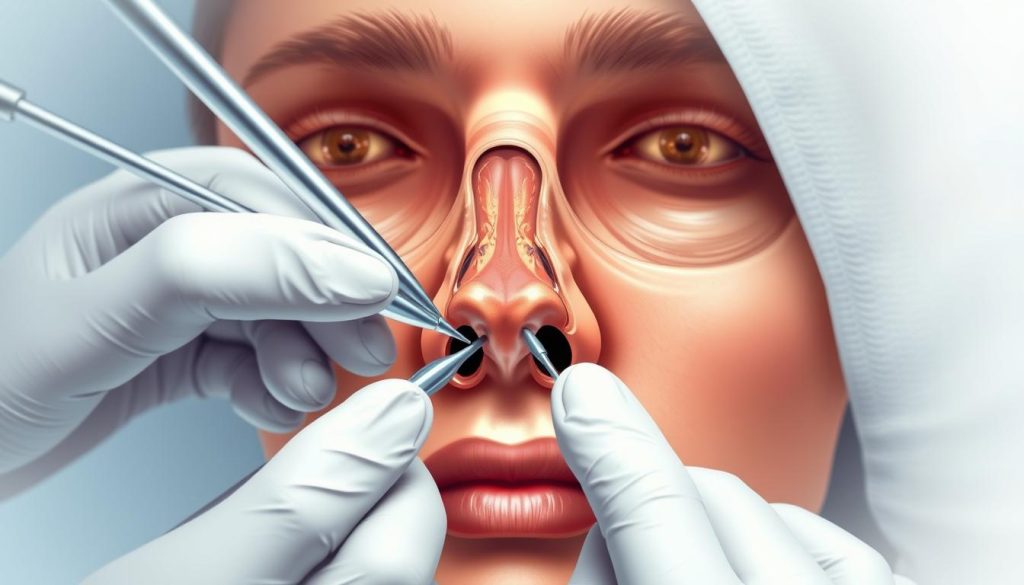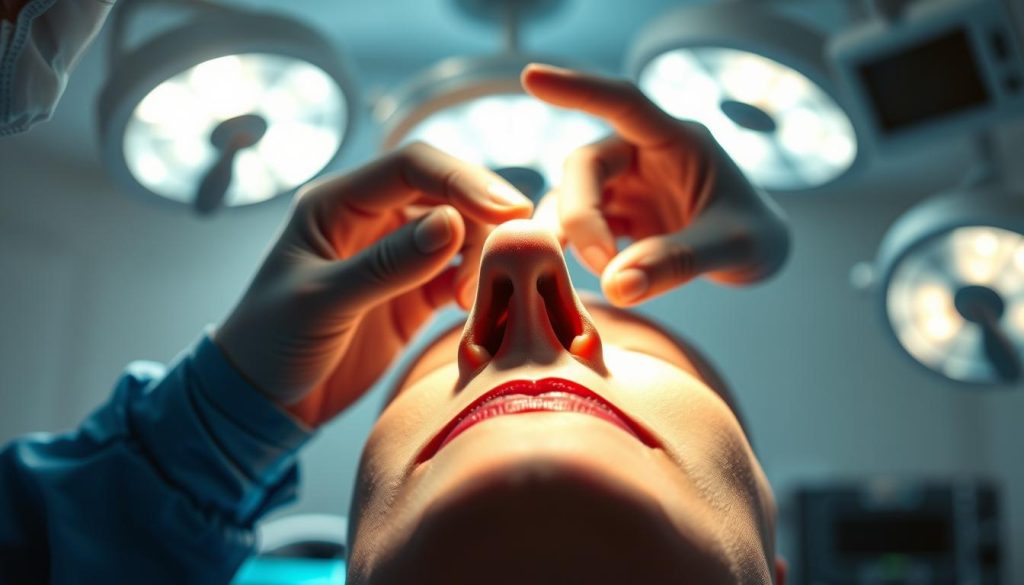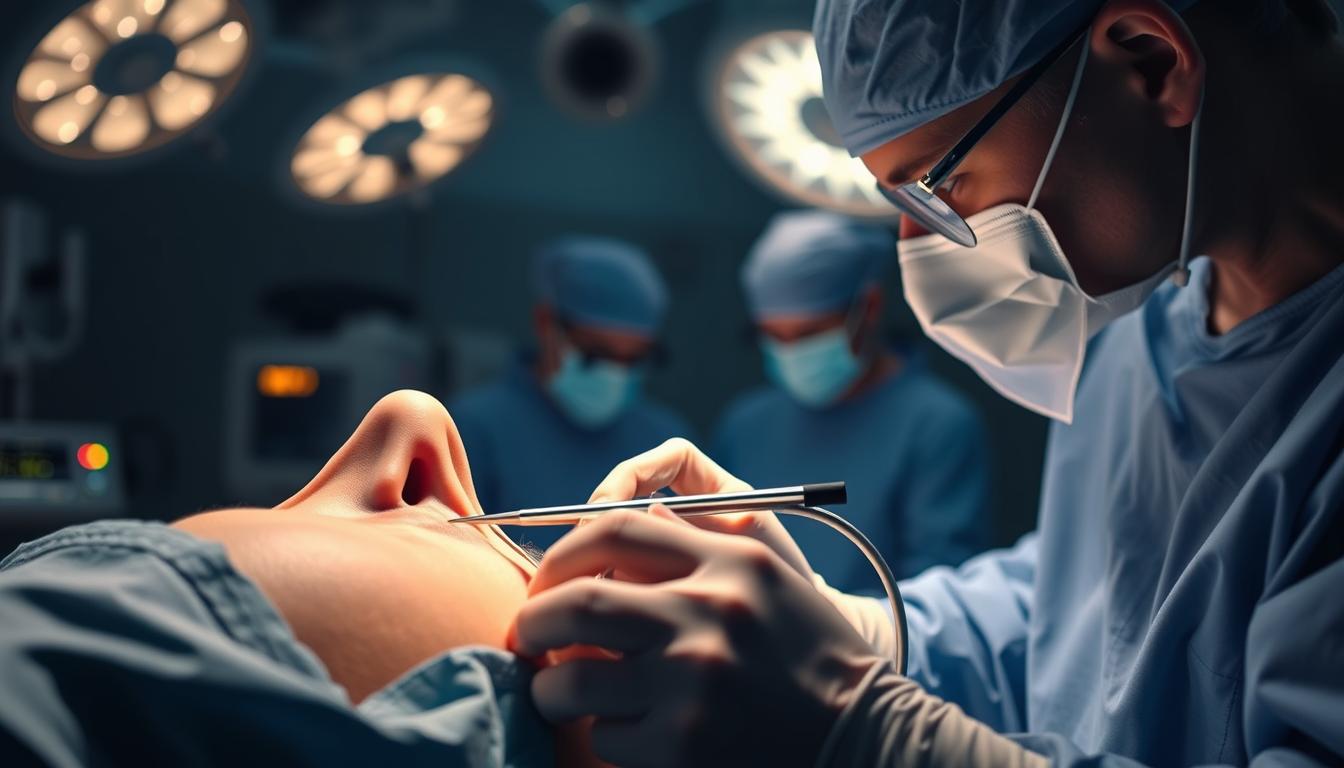Rhinoplasty, commonly referred to as “getting your nose fixed,” is a surgical procedure that can dramatically improve facial harmony and the proportions of your nose. This versatile solution addresses both aesthetic concerns and functional issues, making it a popular choice for patients seeking improvement in appearance and breathing quality.
When performed by a skilled, qualified cosmetic surgeon, rhinoplasty can be a rewarding and life-enhancing procedure. Patients often notice that their overall appearance has improved, as the nose they see now looks natural, like the nose they have always thought they should have.
Key Takeaways
- Rhinoplasty is a highly individualized surgery requiring a skilled surgeon with specific expertise in nasal surgery.
- Modern rhinoplasty techniques address both aesthetic concerns and functional issues.
- The procedure involves reshaping nasal structures to achieve desired improvements.
- Patients considering rhinoplasty should understand the importance of a qualified cosmetic surgeon.
- Rhinoplasty can dramatically improve facial harmony and the proportions of your nose.
Understanding Rhinoplasty: More Than Just a Nose Job
For many individuals, rhinoplasty represents more than just a cosmetic procedure; it’s an operation that can improve breathing, correct nasal deformities, and enhance overall quality of life. This multifaceted surgery is designed to address a range of concerns, from the aesthetic appearance of the nose to its functional capabilities.
What is Rhinoplasty?
Rhinoplasty is a sophisticated surgical procedure that modifies the structure of the nose to improve both its appearance and functionality. It’s a highly customizable operation that can address various nasal concerns, making it much more than just a cosmetic “nose job.”
Functional vs. Cosmetic Benefits
The benefits of rhinoplasty are twofold. On the functional side, it can improve breathing, enhance sleep quality, and resolve chronic sinus issues. Cosmetically, it aims to create facial harmony and balance by adjusting the shape and size of the nose.
Who Makes a Good Candidate
Ideal candidates for rhinoplasty include individuals who have completed facial growth, are in good overall health, don’t smoke, and have realistic expectations about the outcomes. Generally, this means being at least 16 years old for females and 17 for males, although exceptions exist for pediatric patients with certain facial birth defects.
Common Reasons People Get Their Nose Fixed
Rhinoplasty is a versatile procedure that addresses both cosmetic concerns and structural issues of the nose. The goals of nose reshaping are as individual as the patients who choose to have rhinoplasty.
Aesthetic Concerns
Aesthetic concerns motivate many patients to seek rhinoplasty. These include addressing prominent humps or bumps on the nasal bridge, correcting asymmetry, refining a bulbous or drooping tip, and achieving better proportion with other facial features. By reshaping the nasal structure, a cosmetic surgeon can enhance the overall appearance and shape of the nose.
Breathing Difficulties and Structural Issues
Breathing difficulties caused by structural issues like a deviated septum or nasal valve collapse can significantly impact quality of life. Functional rhinoplasty can correct these problems by opening up blocked nasal passages, thereby improving breathing and overall health. This type of rhinoplasty is often a medical necessity rather than just a cosmetic choice.
Post-Traumatic Corrections
Post-traumatic corrections are common after nasal injuries from sports, accidents, or physical altercations. Rhinoplasty can restore symmetry to the nose following injury and correct breathing obstruction. By correcting these issues, patients can achieve both functional and aesthetic improvements.
Types of Rhinoplasty Procedures
The nose can be reshaped through various surgical and nonsurgical rhinoplasty procedures. These procedures cater to different needs, ranging from cosmetic improvements to functional corrections.
Open Rhinoplasty
Open rhinoplasty involves making a small incision across the columella, providing surgeons with direct visualization of nasal structures. This approach allows for more extensive modifications, making it ideal for complex cases.

Closed Rhinoplasty
Closed rhinoplasty uses incisions hidden entirely inside the nostrils, resulting in no visible external scarring and typically less swelling. This approach is best suited for simpler corrections.

Tiplasty
Tiplasty focuses exclusively on reshaping the nasal tip without altering other parts of the nose. It is a less invasive option for patients whose only concern is tip refinement, projection, or rotation.
Image of tiplasty procedure
Nonsurgical Rhinoplasty
Nonsurgical rhinoplasty, also known as liquid rhinoplasty, uses injectable dermal fillers to temporarily alter the nose’s appearance without surgery. It offers immediate results with minimal downtime.
Image of nonsurgical rhinoplasty procedure
Each procedure type has distinct advantages, limitations, and recovery profiles that must be carefully considered alongside the patient’s anatomical needs and aesthetic goals to determine the most appropriate approach.
The Pre-Surgery Process
Understanding the pre-surgery process is vital for a smooth rhinoplasty experience. This phase is crucial in setting the stage for a successful surgical outcome.
Initial Consultation and Assessment
The initial consultation is a critical step where the surgeon evaluates the patient’s nasal structure, facial proportions, skin quality, and breathing function. During this meeting, the patient’s aesthetic goals and medical history are discussed to ensure realistic expectations.
3D Imaging and Planning
Modern rhinoplasty planning often incorporates 3D imaging technology, allowing patients to visualize potential results. This tool helps bridge the communication gap between the patient and surgeon regarding desired changes and expected outcomes.
Preparing for Your Surgery Day
Preparing for rhinoplasty includes following pre-operative instructions, such as avoiding certain medications and supplements, quitting smoking, and arranging for post-operative care. Patients should come prepared with questions and clear communication about their goals to ensure the best possible outcome from their plastic surgery procedure.

What Happens During Nose Surgery
Understanding the intricacies of rhinoplasty surgery is crucial for anyone considering nose surgery. The procedure involves several key steps and considerations.
Anesthesia Options
Patients undergoing rhinoplasty surgery have two primary anesthesia options: general anesthesia, which renders them unconscious, or local anesthesia with sedation, which numbs the nose and relaxes the patient. The choice between these options depends on the complexity of the procedure and the patient’s anxiety level.
Surgical Techniques and Approaches
The surgeon begins by making incisions either inside the nostrils (closed rhinoplasty) or across the columella with additional internal incisions (open rhinoplasty). The skin is then carefully separated from the underlying bone and cartilage framework, allowing for precise modifications. Techniques may include cartilage grafting, bone reshaping, or tissue rearrangement to achieve the desired outcome or to correct a deviated septum.
Duration and Immediate Post-Op Care
The procedure typically lasts between one to three hours, depending on its complexity. After the surgery, the incisions are closed with fine sutures, and external and internal splints may be applied to support the new nasal structure during the initial healing process.
The Recovery Journey After Getting Your Nose Fixed
Rhinoplasty recovery is a multi-faceted process that involves managing discomfort, reducing swelling, and ensuring proper healing. The initial stages are crucial for setting the foundation for the final results.
First Week After Surgery
The first week after rhinoplasty surgery is typically the most challenging, with patients experiencing moderate pain, nasal congestion, and facial swelling that peaks around day 2-3 post-surgery. A nasal splint is usually worn during this period for structural support.
Managing Swelling and Bruising
Swelling and bruising around the eyes and nose are common after rhinoplasty. These symptoms follow a predictable pattern, with bruising typically resolving within 10-14 days. Applying cold compresses and keeping the head elevated can help minimize swelling.
Timeline for Returning to Normal Activities
Patients can usually return to desk work or school after 1-2 weeks. Light exercise can be resumed after 3-4 weeks, and more strenuous activities after 6 weeks. Following post-operative instructions is crucial for a smooth recovery.

Potential Risks and Complications
Understanding the potential risks and complications associated with rhinoplasty is essential for making an informed decision about the surgery. While rhinoplasty can significantly improve the appearance and function of the nose, it’s not without risks.
Common Side Effects
Common side effects following rhinoplasty include temporary swelling, bruising, nasal congestion, minor bleeding, and discomfort. These typically resolve within the first few weeks with proper care and medication. Patients may experience mild to moderate pain or discomfort, which can be managed with over-the-counter pain relievers as directed by their healthcare provider.
Serious Complications to Be Aware Of
More serious complications, though rare, can include infection, adverse reactions to anesthesia, persistent numbness, nasal septum perforation, or unsatisfactory aesthetic results requiring revision surgery. It’s crucial to be aware of these potential problems to take necessary precautions.
Asymmetrical Healing
Asymmetrical healing is a normal but often concerning phenomenon where swelling affects one side of the nose more than the other, creating a temporarily crooked appearance. This typically resolves as swelling subsides over time. Patients should be prepared for this possibility and understand that it’s a part of the healing process.
| Complication | Description | Frequency |
|---|---|---|
| Infection | Bacterial or viral infection post-surgery | Rare |
| Nasal Septum Perforation | Hole in the nasal septum | Rare |
| Asymmetrical Healing | Uneven swelling during recovery | Common |
By understanding these potential risks and complications, patients can better prepare themselves for the surgery and the recovery process. It’s also important to follow all pre and post-operative instructions carefully and attend follow-up appointments to monitor healing.
Results: What to Expect From Your New Nose
Understanding the results of rhinoplasty is crucial for managing expectations. After the surgery, the appearance and shape of the nose will be altered, but the full results take time to manifest.
Short-Term vs. Long-Term Results
In the short term, patients can expect significant changes as swelling subsides over the first few months. Typically, about 70% of the final result is visible after three months. However, it may take around 12-18 months for the nose to fully refine and for all residual swelling to resolve, revealing the true shape and contour.
Realistic Expectations
Maintaining realistic expectations is vital for satisfaction with rhinoplasty results. The goal should be improvement rather than perfection, focusing on achieving a nose that harmonizes with other facial features. Factors such as skin thickness, nasal structure complexity, healing capacity, and the surgeon’s skill all impact the outcome.
When to Consider Revision Rhinoplasty
Revision rhinoplasty may be considered if patients experience persistent breathing difficulties, visible asymmetry after complete healing, or significant dissatisfaction with aesthetic outcomes. It’s generally recommended to wait at least 12 months after the initial surgery before pursuing revision.
Making an Informed Decision About Nose Surgery
The decision to undergo rhinoplasty is significant, and being informed is key to a successful outcome. To achieve the desired results, it’s essential to choose a surgeon with extensive experience in plastic surgery and rhinoplasty procedures.
When selecting a surgeon, consider their qualifications, including board certification in plastic surgery or otolaryngology, and their experience with rhinoplasty. Evaluate their communication style, aesthetic sensibility, and use of computer imaging to visualize potential outcomes.
Understanding the procedure, including the potential risks and benefits, is vital. Consider the financial aspects, including surgeon’s fees and potential insurance coverage for functional components. By being thoroughly informed, you can make a decision that aligns with your goals and expectations, ultimately achieving a harmonious balance between form and function, and successfully shaping your nose to enhance your facial appearance.
FAQ
What is the difference between open and closed rhinoplasty?
Open rhinoplasty involves making an incision between the nostrils, providing a clear view of the nasal structure, while closed rhinoplasty involves making incisions within the nostrils, resulting in less visible scarring.
How long does it take to recover from rhinoplasty surgery?
The initial recovery period typically lasts one to two weeks, during which time patients may experience swelling and bruising. Most people can return to their normal activities within 7-10 days.
Will rhinoplasty improve my breathing?
Rhinoplasty can help alleviate breathing difficulties by correcting issues such as a deviated nasal septum. The surgery can improve the nasal passage and overall respiratory function.
Can I undergo rhinoplasty if I have a deviated septum?
Yes, rhinoplasty can be performed to correct a deviated nasal septum, which can improve both the appearance of the nose and breathing function.
What are the risks associated with rhinoplasty surgery?
As with any surgical procedure, rhinoplasty carries risks such as infection, bleeding, and adverse reactions to anesthesia. It’s essential to discuss these risks with a qualified surgeon.
How long do the results of rhinoplasty last?
The results of rhinoplasty are generally long-lasting, but the aging process and other factors can cause changes over time. Maintaining a healthy lifestyle and following post-operative instructions can help ensure optimal results.
Can nonsurgical rhinoplasty achieve the same results as surgical rhinoplasty?
Nonsurgical rhinoplasty, which involves using fillers to reshape the nose, can provide temporary improvements, but it cannot achieve the same level of correction as surgical rhinoplasty.
